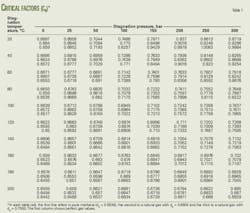Alkylate is in short supply in the US. The renewable fuels standard (RFS) mandates the use of ethanol in gasoline. The high vapor pressure of ethanol requires a reduction in other light gasoline components such as butanes and pentanes in order to meet federal Reid vapor pressure standards. The butane and pentane loss will be about 0.4 gal/1 gal of ethanol added to the gasoline pool.
Octane-based alkylate is a thus a key alternative to compensating for the loss of these light components without adding to the aromatic or olefinic content of the gasoline. A severe alkylate shortage contributed to a spike in gasoline prices in summer 2008.1
Making matters worse, several hydrogen fluoride alkylation units have been shut down over the last decade.
HF alkylation units require extremely high levels of maintenance to ensure safe operation. Accidents have, in some cases, convinced the refinery management to moth ball these units. Three separate accidents involving HF releases at US refineries occurred in a 5-month span during 2009, leading to prolonged shutdowns and investigations by the US Chemical Safety and Hazard Investigation Board, Washington.2
Solid acid-catalyzed alkylation eliminates the hazard and costs associated with using and regenerating corrosive liquid acids such as HF. Solid acids have for many years promised safer and cleaner alkylation.3 The short lifetimes of most solid acids, however, have resulted in expensive processes with complex reactors and large catalyst inventories, making them uncompetitive with liquid acid technology. Competing with liquid acids requires new solid acids that are engineered for optimum performance, rather than selected from existing materials.4
A new engineered solid-acid catalyst has been developed with significantly higher stability, which makes solid-acid alkylation finally competitive with conventional liquid acid technologies. Presented here are the results of a recently concluded study that shows an alkylation process using this new engineered solid-acid catalyst can effectively revamp a mothballed HF unit. According to the results of the study, capital costs for the revamp were minimal while the operating costs were unchanged.
Solid-acid catalyst
The new solid-acid catalyst (SAC) has been engineered on multiple levels,5 as shown in Fig. 2. The catalyst particle shape and size are controlled to provide the proper reaction environment by manipulating the rate of mass transport into and out of the catalyst pellet. In this way, the catalyst reduces the constraints on the reactor design, simplifying the process and reducing overall cost.
The catalyst pore structure has been optimized on both the macro and microscale to enhance the diffusion of large coke molecules out of the catalyst pores, reducing catalyst deactivation that results from pore blockage. The strength and distribution of the active catalyst sites have been tuned to promote alkylation over coke formation. The active sites are adjusted to facilitate formation of 2,3,3- and 2,3,4-trimethylpentane, both of which have octane ratings greater than 100. Cracking and isomerization to dimethylhexanes (DMH) are minimized to maintain high total alkylate octane.
The SAC also has the ability to isomerize 1-butene to 2-butene, leading to higher alkylate octane rating than produced by HF units when using olefin feeds rich in 1-butene. Carefully tuning the catalyst properties at multiple levels achieves all of the desired attributes: long life, high product octane, and simple process design.
Process
Fig. 3 shows the new alkylation process using the engineered SAC process.6 Unique to solid acid-based processes are the two multistaged fixed-bed reactors used in the reaction section. One is used for reaction, while the other is being regenerated.
The olefin stream is mixed with isobutane returning from the distillation section and with the reactor effluent recirculation stream before being fed to the reactor. The alkylation reaction is mildly exothermic.
The robust catalyst is insensitive to small changes in temperature and hence the heat of reaction is removed by a heat-exchanger located on the recycle loop outside the reactor. Table 1 gives typical process conditions for the solid-acid catalyst process.
The remaining portion of the process replicates the function of the fractionation section in the HF unit but with reduced complexity. Because the catalyst is a true solid acid, the acid cannot migrate to other parts of the process. As a result, acid neutralization steps are not required. Maintenance requirements are also reduced because corrosion of critical devices, such as emergency pressure-relief valves, is no longer a concern.
The SAC process operates at temperatures greater than that of HF, reducing the need for extensive cooling of the reaction mixture. Consequently, the reaction pressure must be elevated slightly to maintain the reaction in a liquid state. Feed ratio of isobutane to olefin is the same or lower than HF unit designs.
All alkylation catalysts, solid and liquid, must be continuously regenerated. HF units perform the regeneration through a combination of intense heating to decompose alkyl fluorides and distillation to separate acid from heavy hydrocarbons (coke).
For the SAC unit, catalyst regeneration is performed with a circulating loop of hydrogen-hydrocarbon mixture at an elevated temperature of 250° C. This simple flow scheme (Fig. 4) results in low capital costs and the ability to retrofit existing plants readily.7
Alkylation cycle lengths are designed to be between 12-24 hr to simplify reactor operation. After the alkylation cycle, the reactor is taken off stream and the solid-acid catalyst is regenerated. During this time, the second reactor maintains the constant alkylate production. Due to the small amount of coke build-up on the catalyst surface, hydrogen consumption is kept to a minimum.
HF alkylation retrofit
A study was commissioned by a refiner to determine the feasibility of converting a 3,000-b/sd HF alkylation unit (Fig. 5) into a solid-acid alkylation unit. The goals of the study included developing a workable, low-capital cost design for the revamped unit while maintaining capacity. The study was dedicated to looking at each major equipment item in the current HF unit to identify equipment that can be retained in either its current service or looking for innovative ways of reusing it.
Based on a preliminary evaluation of the unit data provided by the refiner, Exelus Inc. has developed a design for the HF unit revamp. Each section of the existing unit was analyzed and compared with the requirements of the SAC process. The new SAC-based alkylation is fundamentally the same as HF alkylation with the notable difference of using an inherently safer catalyst technology.
Consequently, a revamp of an existing HF unit to use a SAC allows much of the equipment to continue in its current service. The most cost-effective revamp option is to retain the existing distillation configuration and replace the HF reactor with new fixed-bed alkylation reactors. Many other sections of the existing unit would be retained in their current capacity in order to achieve minimal capital cost.
• Feed zone. The feed section of the HF unit included a butane splitter, feed driers, and feed storage tanks and pumps. The revamp design retains these units in their entirety under their current service. The revamped unit utilizes the same feed rates and conditions as the HF unit, allowing these units to continue their operation unchanged.
• Reaction zone. The SAC fixed-bed reactors differ in design from conventional HF mixer settlers; so there is no easy way of retrofitting the HF reactors for use in SAC systems. The SAC process therefore requires two new fixed-bed reactors and their associated recirculation pumps.
The SAC reactors, however, require an effluent surge vessel to hold the liquid contents of a reactor while it is being regenerated. The HF settler tank is suitable for this service and is reused. The surge vessel is simply a holding tank and requires no particular internals. The settler can be used without modification for this purpose, which is not significantly different from its current service.
• Separation zone. The distillation sections of the two units are identical and operate at the same isobutane-to-olefin ratio. Therefore, the existing isostripper (main fractionator) and depropanizer columns continue in their present services while unit capacity is maintained.
Column operation and maintenance are simplified by eliminating the presence of HF in the columns. Product purity specifications are maintained because the column's feed composition and flow are unchanged by the revamp. Smaller operations related to HF capture, such as the HF stripper, are idled.
• Product finishing zone. No leaching of acid is possible from the SAC. Therefore, product washing and neutralization steps, including the defluorinator and caustic (KOH) treaters are idled. The solid waste generated from the neutralization steps is also eliminated, reducing operating cost and complexity. Product coolers and storage tanks are retained in their current service.
• Regeneration zone. The equipment needed for regenerating the SAC differs from that used to regenerate HF. Many pieces of equipment available in an HF plant, however, can be modified for use in the SAC regeneration cycle.
For example, the fired heater can be used to raise the regeneration gas stream to 250° C. The HF unit uses a fired heater as a reboiler for the main fractionator in order to achieve temperatures high enough to decompose alkyl fluorides formed in the reactor. Such high temperatures are no longer required in the SAC process.
This fired heater can be reserviced for the SAC regeneration and a new reboiler installed in place of the fired heater. The new reboiler can be steam heated in order to reduce maintenance and safety concerns.
The following list summarizes the breakdown of new and retained equipment for the revamp.
Systems retained without modification:
• Feed driers.
• Feed drums and pumps.
• Distillation columns.
• Distillation column supporting equipment (drums, reboilers, condensers).
• Product coolers and storage tanks.
• Energy optimizing heat exchangers in distillation train.
Systems retained in new service:
• Reactor-settler becomes surge vessel.
• Main fractionator's fired heater reboiler becomes regeneration fired heater.
New equipment:
• Alkylation reactors (two).
• Reactor recirculation pumps (three).
• Regeneration compressor.
• Regeneration separator vessel.
• Regeneration heat interchanger.
• Main fractionator's steam reboiler.
Revamp cost
Table 2 gives equipment costs for revamping a 3,000-b/d HF unit to a SAC system. These costs were developed with in-house correlations and algorithms, updated to second-quarter 2008 US Gulf Coast prices. Reactors and supporting vessels are priced according to a power-law dependence of the vessel mass. Heat exchangers are priced by a scaled heat duty.
Compressor and pumps are fixed price based on vendor estimates. Installation costs are calculated from typical scale factors for each equipment type and are summed at the bottom of the table to provide an estimate for total installed cost.
Table 2 shows that the single largest expense, as expected, is for the new reactor vessels. These reactors are the heart of the new alkylation process. The remaining cost is distributed evenly among the remaining equipment. Identifying additional idle equipment that can be used for one of the required services will further reduce costs.
The cost for the revamp is less than $3,000/b/d of capacity, which is less than 20% of the cost of a grassroots sulfuric acid plant (including acid-regeneration facility). The SAC-based alkylation revamp is lower in cost than any other revamp option.
The SAC revamp also requires only minor modifications of existing equipment; most is used without any modification. In the case of revamping an operational alkylation unit, the majority of the construction (reactors, recirculation cooler and pumps, and regeneration equipment) can be installed without shutting down the existing unit. This option minimizes downtime and maximizes the profitability of the unit.
Revamp benefits
Most HF revamp projects are driven by safety concerns, either due to an accident or near miss internally at the refinery, or externally, from newly adopted legal requirements. A solid acid catalyst is an Inherently Safer Technology (IST) than liquid acids because it is noncorrosive and nonhazardous. Conversion of an HF unit to an SAC system eliminates the risks of storing, transporting, and using large quantities of HF.
There are, however, financial rewards for such a revamp as well. Reducing the operational risks of a refinery unit also reduces the associated costs. Spill-mitigation equipment such as water curtains are no longer needed, reducing maintenance and testing. Overhead costs related to emergency planning, personal protective regimens and equipment, and liability are also eliminated.
Solid-waste disposal and the purchasing, transport, and storage of HF and caustic are both removed as operating costs. Frequent metallurgical inspections and part replacement to compensate for HF-induced corrosion are also rendered unnecessary.
Conversion of an HF unit to a SAC-based one reduces these costs without sacrificing profitability. In this case study, the unit capacity and alkylate octane are maintained. Operating costs are also largely unchanged. Feedstock consumption is similar in each.
The primary utility consumer in both an HF and an SAC alkylation unit is the fractionation section, which is identical for the two units. Additional power consumption in the reactor's recirculation pumps and regeneration compressor is offset by a reduced number of pumps in the product-finishing area and lower reaction cooling-water requirements. The SAC system consumes additional fuel gas and a small quantity of reformer-grade hydrogen in the regeneration loop compared to HF but eliminates caustic, fresh HF, and waste water treatment costs.
The SAC-based revamp considered here also showed significant benefits over other revamp possibilities. Conversion of an HF unit to sulfuric acid requires a significant capital expenditure and does not adequately address the risks of using liquid acids in refinery applications. The transport, storage, and use of sulfuric acid for alkylation have led to numerous accidents and fatalities and it complicates fire fighting efforts.
A revamp to sulfuric acid requires new reactors (contactors), a large refrigeration system, plus infrastructure to handle, store, and transport large quantities of fresh and spent acid, owing to the high acid consumption. Unlike with HF, sulfuric acid is not regenerated within the alkylation unit but instead requires a large, external, dedicated regeneration facility. The capital cost for such a revamp is substantial and in some cases unfeasible due to the refinery's location.
The engineered SAC considered for use in this revamp is designed to provide long catalyst cycle time and low catalyst inventory compared with other available SACs. These technological benefits further minimize the cost of the revamp by reducing the size, complexity, and number of reactors as well as minimizing catalyst cost.
Meeting IST directives
SAC-based alkylation technology affords the ability to convert one of the most dangerous refinery operations into one of the safest without sacrificing profit or performance.8 Such a catalyst forms the core of a safe and efficient process that generates high-octane alkylate without the dangers and costs associated with liquid acid technology.9
Revamping an HF alkylation unit to use a solid-acid catalyst is a cost-effective means to comply with new Inherently Safer Technology legislation, restart an HF unit idled after an accident or near-miss, or simply to improve overall plant safety.
References
1. "Analysts See Possible Alkylate Shortage," Octane Week, February 2008.
2. Dittrick, P., "USW seeks phaseout of HF alkylation units," OGJ Online, Aug. 31, 2009.
3. D'Aquino, R., and Mavridis, L., "Solid-Acid Catalysts Shape Up for Alkylation," Chemical Engineering Progress, Vol. 103, No. 1 (2007), pp. 8-9.
4. Mukherjee, M., and Nehlsen, J., "Consider catalyst developments for alkylation production," Hydrocarbon Processing, Vol. 85, No. 9 (2006), pp. 85-96.
5. Mukherjee, M., and Nehlsen, J., "Reduce alkylate costs with solid-acid catalysts," Hydrocarbon Processing, Vol. 86, No. 10 (2007), pp. 110-114.
6. Mukherjee, M., et al., Developments in Alkylation. Hydrocarbon Engineering, Vol. 12, No. 7 (2007), pp. 25-28.
7. Mukherjee, M., et al., "Step-Out Paraffin Alkylation Process using Engineered Solid-Acid Catalyst," Hydrocarbon World, Vol. 3, No. 1.
8. Verbitsky, D., Mukherjee, M., and Nehlsen, J., "Upgrading an olefin polymerization unit," Petroleum Technology Quarterly, Vol. 12, No. 4 (2007), pp. 83-89.
9. Mukherjee, M., et al., "Scale-up strategy applied to solid-acid alkylation process," OGJ, July 10, 2006, p. 48.
The authors
More Oil & Gas Journal Current Issue Articles
More Oil & Gas Journal Archives Issue Articles







